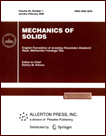 | | Mechanics of Solids
A Journal of Russian Academy of Sciences | | Founded
in January 1966
Issued 6 times a year
Print ISSN 0025-6544
Online ISSN 1934-7936 |
Archive of Issues
| Total articles in the database: | | 13362 |
| In Russian (Èçâ. ÐÀÍ. ÌÒÒ): | | 8178
|
| In English (Mech. Solids): | | 5184 |
|
| << Previous article | Volume 60, Issue 4 / 2025 | Next article >> |
| V.A. Babeshko, O.V. Evdokimova, O.M. Babeshko, and V.S. Evdokimov, "On Dynamic Contact Points Problems with Dies of Complex Rheologies in the Quarter Plane of an Anisotropic Composite," Mech. Solids. 60 (4), 2376-2384 (2025) |
| Year |
2025 |
Volume |
60 |
Number |
4 |
Pages |
2376-2384 |
| DOI |
10.1134/S0025654425601107 |
| Title |
On Dynamic Contact Points Problems with Dies of Complex Rheologies in the Quarter Plane of an Anisotropic Composite |
| Author(s) |
V.A. Babeshko (Kuban State University, Krasnodar, 350040 Russia, babeshko41@mail.ru)
O.V. Evdokimova (Southern Scientific Center of the Russian Academy of Sciences, Rostov-on-Don, 344006 Russia)
O.M. Babeshko (Kuban State University, Krasnodar, 350040 Russia)
V.S. Evdokimov (Kuban State University, Krasnodar, 350040 Russia) |
| Abstract |
In this paper, for the first time, a solution is constructed to the dynamic contact problem of
the time-harmonic effect of a deformable die on a layer of anisotropic composite material. It is
assumed that the die occupies the region of the first quadrant and has a complex rheology, in particular, the linear theory of elasticity. The paper uses a universal modeling method developed by the
authors, which makes it possible to apply the block element method to both differential and integral
equations. The solutions of boundary value problems for deformable dies of complex rheology are
constructed in the form of decompositions according to the solutions of boundary value problems for
materials of simple rheology described, for example, by Helmholtz equations. This possibility was previously established for materials of a wide range of rheology by using Galerkin transformations. The
solution of the two-dimensional Wiener-Hopf integral equation is obtained both in coordinate form
and in Fourier transforms. This makes it particularly convenient to further study it using analytical or
numerical methods using standard computer programs. They will make it possible to identify certain
properties of composites used as structural materials in various engineering technologies dictated by
types of anisotropies, as well as in issues of seismology in the study of seismicity in mountainous areas.
The constructed integral representation of the solution of the contact problem, which makes it possible to identify terms describing the concentrations of contact stresses under the die, makes it possible
to select the soles of deformable dies or the properties of the materials used to get rid of undesirable
concentrations of contact stresses or enhance them. Since Vorovich resonances can occur during
vibration in contact problems with a deformable die, systems of equations are constructed in the work
that allow, when solved, to obtain a dispersion equation for finding resonant frequencies. |
| Keywords |
contact problems, deformable die, anisotropy, composite, two-dimensional Wiener-Hopf integral equation, wedge-shaped region, block element |
| Received |
08 March 2025 | Revised |
20 March 2025 | Accepted |
22 March 2025 |
| Link to Fulltext |
|
| << Previous article | Volume 60, Issue 4 / 2025 | Next article >> |
|
 If you find a misprint on a webpage, please help us correct it promptly - just highlight and press Ctrl+Enter If you find a misprint on a webpage, please help us correct it promptly - just highlight and press Ctrl+Enter
|
|

 Russian
Russian  English
English